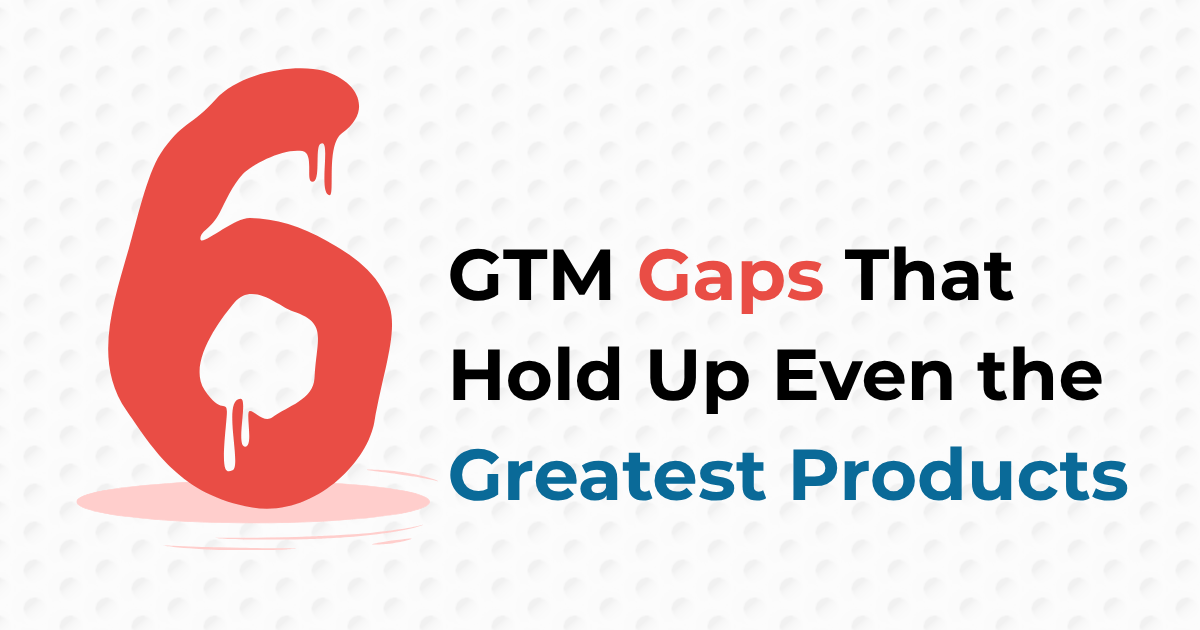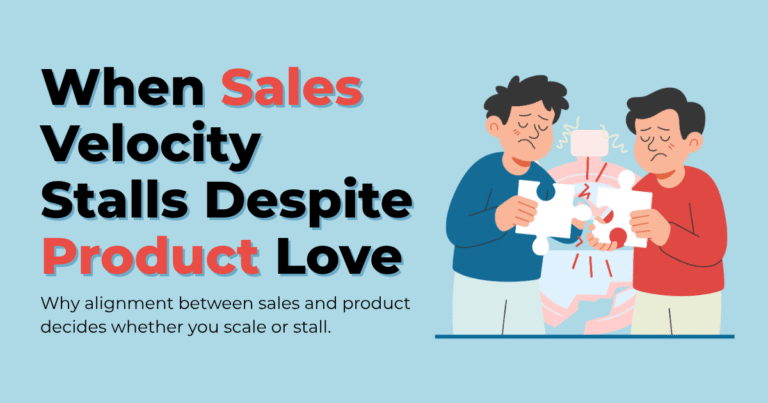One of the toughest realities for founders to swallow: incredible products won’t sell themselves.
Year after year, talented teams with truly innovative solutions fail — not due to a weak product, but because the go-to-market (GTM) system contained unseen gaps.
These gaps are hidden. They won’t appear in your product roadmap or pitch deck. But they appear in the metrics: flat ARR, high churn, long sales cycles, falling revenue targets.
The best part? Once you are able to diagnose your GTM gaps, you can address them before they kill your runway.
KEY TAKEWAYS
- System Trumps Product: A great product needs a great system. Traction is engineered, not automatic. You will fall to the level of your system, not rise to the level of your product.
- Misalignment Costs Revenue: The core failure is GTM misalignment, not “no need.” These hidden gaps incinerate runway and lead directly to flat ARR and high churn.
- The 6 Fixable Flaws: GTM failure is traceable to six specific gaps: ICP, Messaging, Sales Process, Metrics, Demand-Gen, and Post-Sale. They are all fixable.
- Diagnose Before Scaling: Scaling a broken GTM system only burns money faster. Diagnose your GTM gaps first to ensure your growth is repeatable and predictable.
- Invest in Predictability: Investors buy traction, not potential. Fill these gaps with organized playbooks to turn product potential into predictable growth.
Why GTM Gaps Are Deadly
As per CB Insights, 35% of startups fail due to there’s no market need. In reality, however, most don’t actually have “no need.” They have a misalignment problem — they’re not communicating, positioning, or reaching customers the correct way.
GTM is like an engine. If something is out of alignment — fuel, spark, timing — the car won’t drive well, regardless of how strong the engine is.
The 6 Most Common GTM Gaps
1. ICP Misalignment
Your Ideal Customer Profile (ICP) is the starting point. Mess this up, and the rest of it falls apart.
- Symptom: Plenty of conversations, hardly any closes.
- Cause: Targeting people who “could” benefit from the product, rather than those who need to address the issue immediately.
Stat: Startups with a well-defined ICP are 2–3x more likely to meet revenue targets (HubSpot).
2. Weak Messaging
Even with the proper ICP, bad messaging blows deals up. If your story doesn’t connect, prospects disconnect.
- Symptom: Buyers don’t “get it” in a hurry.
- Cause: Messaging is feature-driven rather than pain-driven.
Stat: Gartner discovered that buyers are 2.8x more likely to select a vendor that tells a clear value story.
3. Demand-Gen Scatter
Founders tend to attempt “a little bit of everything” — LinkedIn, paid advertising, events, cold emailing. Without direction, channels lose money.
- Symptom: High spend, variable results.
- Cause: No repeatable lead gen playbook.
Stat: As per Demand Gen Report, 79% of B2B marketers report their greatest challenge is generating sufficient high-quality leads.
4. Sales Process Bottlenecks
Even with solid leads, a broken sales process can freeze momentum. Reps improvise, bypass discovery, or fail to use consistent playbooks.
- Symptom: Deals lingering in pipeline for months.
- Cause: No formal sales methodology or enablement.
Stat: Businesses with a formal sales process experience 28% greater revenue growth than businesses without (Harvard Business Review).
5. Misaligned Metrics
Marketing is chasing MQLs. Sales is chasing closed deals. Success looks different to each team, and alignment breaks.
- Symptom: Finger-pointing between sales and marketing.
- Cause: Vanity metrics over revenue-driven metrics.
Stat: Forrester reports that companies with aligned sales and marketing see 24% faster revenue growth.
6. Post-Sale Neglect
Many startups obsess about acquisition but forget adoption, success, and retention. Without customer advocacy, growth stalls.
- Symptom: High churn, low referrals.
- Cause: No customer success playbook.
Stat: Bain & Company discovered that improving customer retention by only 5% will drive an increase in profits of 25–95%.
The GTM Gap Framework
This is how we diagnose GTM failures at NoirDove:
- ICP Fit Check → Are we pursuing the right customers?
- Message Audit → Is the story talking to pain, in their own words?
- Channel Review → Which demand-gen motions are actually repeatable?
- Sales Enablement → Is there a repeatable discovery-to-close process?
- Revenue Alignment → Are marketing + sales rewarded on the same metrics?
- Customer Loop → Do we have advocacy, upsell, and retention built-in?
As you overlay your GTM against these six checkpoints, the gaps become apparent — and fixable.
Why Even Great Products Stall
The brutal truth is, a great product without a GTM system is merely potential energy.
Investors don’t invest in potential — they invest in traction. Buyers don’t buy technology — they buy clarity. Teams don’t scale — systems do.
Founders who overlook GTM gaps get stuck in the “almost-there” trap: tons of calls, some pilots, minimal predictable revenue.
Last Thought: Diagnose Before You Scale
Scaling a broken GTM system doesn’t make it better. It just incinerates money quicker.
Before you bring on more reps, fire up more campaigns, or pursue new markets, stop. Ask:
- Do we have ICP clarity?
- Is our messaging clear and coherent?
- Are our channels reproducible?
- Do sales and marketing have a common definition of success?
- Are customers remaining and promoting?
Because in GTM, you don’t rise to the level of your product, you fall to the level of your system.
Frequently Asked Questions (FAQs) by GTM Leaders
1. If I have multiple GTM Gaps, where should my company focus first?
You must start with ICP Misalignment (Gap 1). Without absolute clarity on who needs your product right now (your Serviceable Customer Profile), every dollar spent on messaging, ads, or sales resources is fundamentally wasted. Fix your “who” before optimizing your “how.”
2. How long will it take to see results after we fix a major gap?
Impact varies by gap. Fixing Weak Messaging (Gap 2) can show initial results in 4-6 weeks (higher response rates, better demo attendance). Addressing Post-Sale Neglect (Gap 6) yields long-term results, visible in improved Net Revenue Retention (NRR) after 6 months.
3. Does fixing these gaps mean we need to buy expensive enterprise software?
No. These gaps are caused by a process failure, not a tool failure. We always start by auditing and maximizing your existing lean tech stack (CRM, etc.). The goal is alignment and a repeatable playbook, not new software contracts.
4. We are a small team. How can we afford the time or bandwidth to run a full GTM system?
The purpose of a structured GTM system is to create efficiency. By automating non-strategic tasks (Demand-Gen Scatter) and implementing a clean Sales Process Playbook, your small team focuses only on high-leverage activities—closing deals and strategic development—instead of constant improvisation.
5. We have some leads, but they are stuck. What is the most deadly gap holding up our pipeline?
Usually, the bottleneck is a tie between Sales Process Bottlenecks (Gap 4) and Misaligned Metrics (Gap 5). Leads stall when reps improvise, or when sales and marketing aren’t unified on a clear, shared definition of a Sales Qualified Lead (SQL). Fix the process and align the metrics, and pipeline velocity will improve.
We at NoirDove assist founders to find and fill GTM gaps with organized playbooks, so their product genius truly works in the form of predictable growth.




